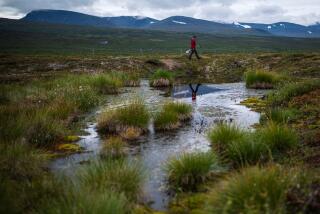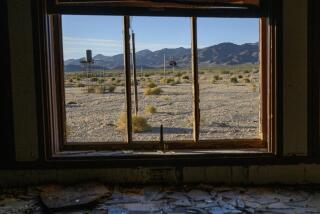Climate change has a firm grip
Even if by some miracle the nations of the world could bring carbon dioxide levels back to those of the pre-industrial era, it would still take 1,000 years or longer for the climate changes already triggered to be reversed, scientists said Monday.
The gas already here and the heat that has been absorbed by the ocean will exert their effects for centuries, according to an analysis published in the Proceedings of the National Academy of Sciences.
Over the long haul, the warming will melt the polar icecaps more than had previously been estimated, raising ocean levels substantially, the report said.
And changes in rainfall patterns will bring droughts to the American Southwest, southern Europe, northern Africa and western Australia comparable to those that caused the 1930s Dust Bowl in the U.S.
âPeople have imagined that if we stopped emitting carbon dioxide, the climate would go back to normal in 100 years, 200 years,â lead author Susan Solomon, a senior scientist at the National Oceanic and Atmospheric Administration, said in a telephone news conference. âThatâs not true.â
The changes will persist until at least the year 3000, said Solomon, who conducted the study with colleagues in Switzerland and France.
Scientists familiar with the report said it emphasized the need for immediate action to control emissions.
âAs a climate scientist, this was my intuition,â said geoscientist Jonathan T. Overpeck of the University of Arizona. âBut they have done a really good job of working through the details and . . . make a case that the situation is more dire than we thought if we donât act quickly and aggressively to curb carbon dioxide emissions.â
Kevin Trenberth, head of climate analysis at the National Center for Atmospheric Research in Boulder, Colo., said the persistence of climate change caused by global warming was âpoorly appreciated by policymakers and the general public, and it is real.â
âThe policy relevance is clear: We need to act sooner, even if there is some doubt about exactly what will happen, because by the time the public and policymakers really realize the changes are here, it is far too late to do anything about it,â Trenberth said.
The report came as President Obama ordered the Environmental Protection Agency to consider allowing states the right to enact auto emission standards stricter than federal rules.
Secretary of State Hillary Rodham Clinton also is expected to appoint a new envoy for climate change to bolster the administrationâs credentials in environmental policy.
The slowness with which ocean water circulates is central to the new findings. Carbon dioxide is primarily removed from the atmosphere through absorption into seawater, an incredibly slow process because of the time it takes for surface water saturated with the gas to be replaced by deeper water that can further absorb carbon dioxide.
That gas accounts for about half of the global warming caused by greenhouse gases, but the other gases are removed from the atmosphere more quickly. Thus, the long-term influence of carbon dioxide will have the greatest effect on climate change, the report said.
Moreover, heat absorbed by the ocean is released slowly, and will continue to contribute to global warming even if the concentration of greenhouse gases should decline, the authors said.
Solomon said in a statement that absorption of carbon dioxide and release of heat -- one acting to cool the Earth and the other to warm it -- would âwork against each other to keep temperatures almost constant for more than 1,000 years.â
Geoscientist Jorge L. Sarmiento of Princeton University said, âThis is really a wake-up call about the seriousness of this issue.â
The study looked particularly at ocean levels and rainfall. The team found that by thermal expansion of ocean water alone, sea levels will rise from 1.3 to 3.2 feet if carbon dioxide climbs from the current level of 385 parts per million to 600 parts per million, and twice that if it peaks at 1,000 parts per million.
Melting of the icecaps could increase sea levels even more, inundating low-lying islands and continental shorelines, but the effects are too uncertain to quantify, Solomon said.
Reductions in rainfall would also last centuries, the report said, decreasing drinking water supplies, increasing fire frequency and devastating dry-season farming of wheat and maize.
--






